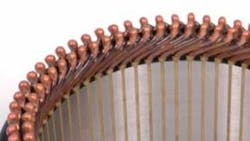Next hot technology: EV motors
The U.S. has a new electric motor maker: General Motors.
GM has a pilot plant in Wixom, Mich. building prototype electric motors for EVs. Manufacturing equipment and processes developed there will eventually move to a mass production facility near Baltimore, Md. in 2013 for building 85-kW motors going into the Chevy Spark EV, also due out that year.
With the numerous high-quality electric motor makers domiciled in the U.S., you might wonder why GM thinks it needs to build its own. GM execs say this strategy has nothing to do with a not-invented-here syndrome.
GM Engineering Director for Hybrid and Electric Architecture and Electric Motors Pete Savagian explains that electric machines have become vital to the future of EVs, so GM thinks it must master their technology. "We believe we need to extend our manufacturing and engineering so we know how to balance requirements such as power, cost, and noise/vibration/harshness. Even the best suppliers are relatively new at it," he says.
Also, EVs pose constraints that conventional electric motor makers aren't accustomed to working with. "An EV like the Volt will have power rating of 100 kW. But a conventional NEMA frame at 100 kW is going to be huge and it won’t fit in that space," says Savagian.
Moreover, EV motor power densities are huge, somewhere north of 4 kW/kgm in peak power with continuous power in the range of 2 kW/kgm. Savagian likens these figures to those of aircraft generators or machine tool drives and says ordinary motor makers aren't geared up to produce product able to work at these levels.
To these ends, GM has invested in technology for motors containing bar-wound stators using rectangular conductors. The rectangular wire "boosts power density because we can get higher fill in the stator. More copper in the slot and less copper in the end turn," says Savagian. "The copper in the end turn is purposely designed as a lattice of rectangular conductors that have a surface-area-to-volume ratio three times higher than that of a round wire bundle yet has shorter end turn."
One other reason GM sees an imperative to master electric motor technology is that some of the necessary expertise comes from other automotive areas. For example, GM expects to oil-cool its electric motors using techniques perfected on automatic transmissions. "Traditional electric motor makers don’t know too much about automatic transmissions," says Savagian. "There could be solutions at hand for major problems which they are unaware of."
The same oil that lubricates the drive train also gets sprayed on the stator housing and then drips into a sump. It gets pumped from there onto winding heads and is also introduced into the center of the rotor. As it flows out the end, it flings off to wet the inside diameter of the stator, providing additional cooling when the motor turns at high speeds.
The automaker is developing both permanent-magnet dc motors and ac induction motors for powering EVs. The PM motors will go into uses characterized by high loads and moderate speeds where this technology is most efficient. Induction motors make sense at higher speeds and lighter loads, says Savagian, where their efficiency is comparable to that of PM motors.The eAssist powertrain in the Buick LaCrosse, for example, uses an induction motor. The Chevy Volt uses rare-earth PM machines.
GM engineers are also trying to minimize the NVH (noise, vibration, and harshness) that electric motors generate. They are particularly trying to design out the high-frequency "buzz" associated with motor operation. This sound comes from "stator windings jumping around the end turns," says Savagian. "It is cool for awhile but after about 100 miles of it, you would prefer to hear nothing. We are putting a lot of design effort into finite-element magnetic design, lowering torque ripple, and reducing forces that tend to strain the stator and make those noises."
Our sister publication Wards Auto did a piece giving a few more details on GM's Wixom motor facility: http://viewer.zmags.com/publication/15ed1ae2#/15ed1ae2/6
